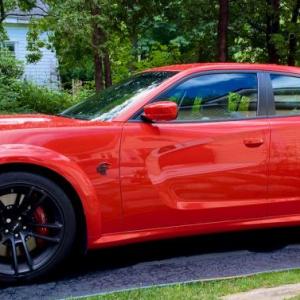Dodge Charger Hellcat Widebody SRT
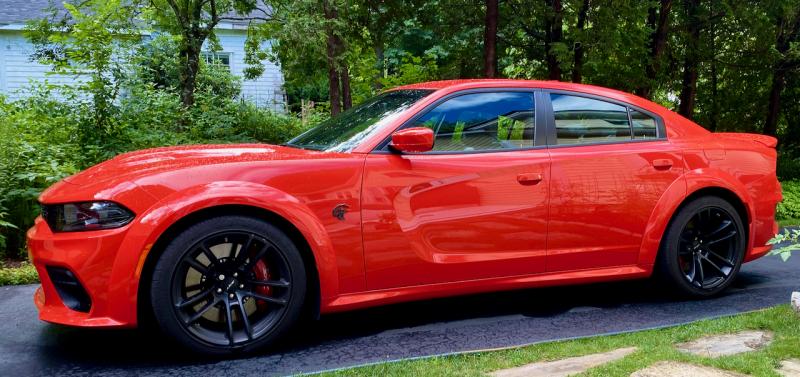 Especially in beefed-up Widebody trim, the Hellcat is a large car. What would it be like as a more-nimble two-seat coupe? Then we’d have another berserk Dodge, the Viper, discontinued in 2017 because it couldn’t fit side-curtain airbags. This color is Go Mango. It certainly is.
Especially in beefed-up Widebody trim, the Hellcat is a large car. What would it be like as a more-nimble two-seat coupe? Then we’d have another berserk Dodge, the Viper, discontinued in 2017 because it couldn’t fit side-curtain airbags. This color is Go Mango. It certainly is.
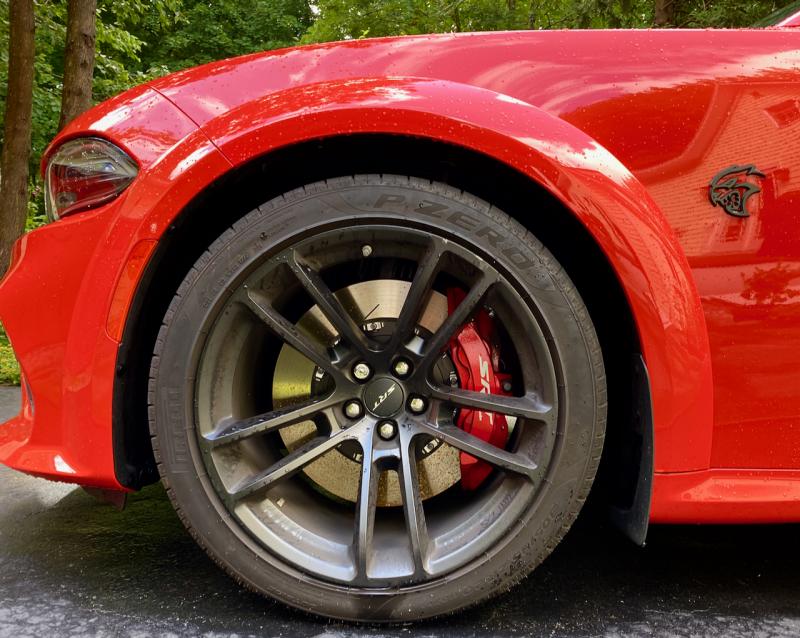 A serious powerplant demands serious brakes. These are Italian-made 6-piston Brembo anchors inside 20-inch, deep-dish forged-aluminum wheels with top-rated Pirelli P Zero tires.
A serious powerplant demands serious brakes. These are Italian-made 6-piston Brembo anchors inside 20-inch, deep-dish forged-aluminum wheels with top-rated Pirelli P Zero tires.
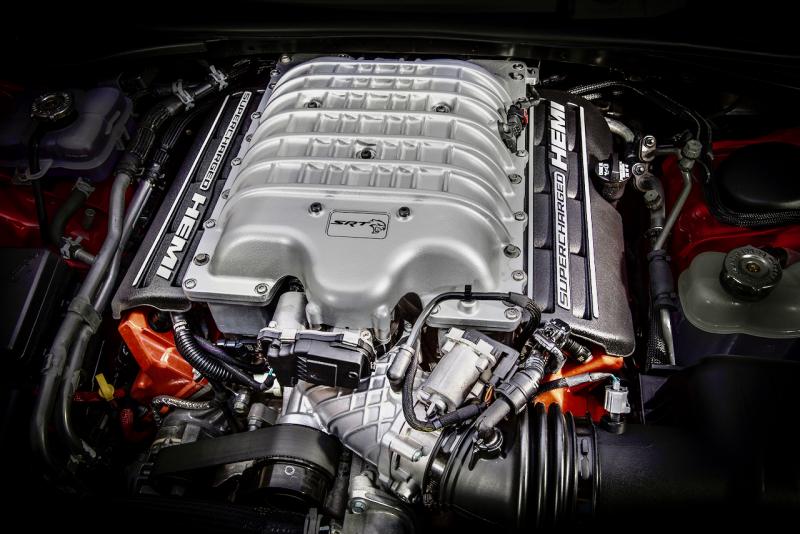 Yes, it’s a Hemi—a 6.2-liter overhead-cam V-8 fitted with a supercharger, specially forged and hardened crankshaft, pistons and connecting rods, high-load bushings and bearings, and aluminum-alloy cylinder heads toughened for extra heat. Be careful: In “normal” or Redeye form, it can turn rear tires into smoke and goo.
Yes, it’s a Hemi—a 6.2-liter overhead-cam V-8 fitted with a supercharger, specially forged and hardened crankshaft, pistons and connecting rods, high-load bushings and bearings, and aluminum-alloy cylinder heads toughened for extra heat. Be careful: In “normal” or Redeye form, it can turn rear tires into smoke and goo.
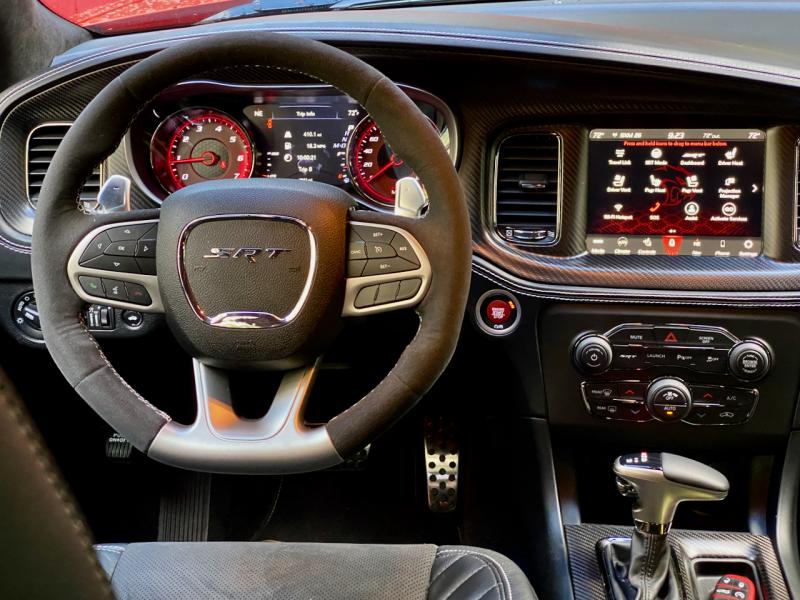 It may not be pretty, but from the meaty steering wheel to the touchscreen with GPS, Apple CarPlay and Android Auto to actual knobs and buttons, the Charger SRT Hellcat cockpit means business.
It may not be pretty, but from the meaty steering wheel to the touchscreen with GPS, Apple CarPlay and Android Auto to actual knobs and buttons, the Charger SRT Hellcat cockpit means business.
 Especially in beefed-up Widebody trim, the Hellcat is a large car. What would it be like as a more-nimble two-seat coupe? Then we’d have another berserk Dodge, the Viper, discontinued in 2017 because it couldn’t fit side-curtain airbags. This color is Go Mango. It certainly is.
Especially in beefed-up Widebody trim, the Hellcat is a large car. What would it be like as a more-nimble two-seat coupe? Then we’d have another berserk Dodge, the Viper, discontinued in 2017 because it couldn’t fit side-curtain airbags. This color is Go Mango. It certainly is.
 A serious powerplant demands serious brakes. These are Italian-made 6-piston Brembo anchors inside 20-inch, deep-dish forged-aluminum wheels with top-rated Pirelli P Zero tires.
A serious powerplant demands serious brakes. These are Italian-made 6-piston Brembo anchors inside 20-inch, deep-dish forged-aluminum wheels with top-rated Pirelli P Zero tires.
 Yes, it’s a Hemi—a 6.2-liter overhead-cam V-8 fitted with a supercharger, specially forged and hardened crankshaft, pistons and connecting rods, high-load bushings and bearings, and aluminum-alloy cylinder heads toughened for extra heat. Be careful: In “normal” or Redeye form, it can turn rear tires into smoke and goo.
Yes, it’s a Hemi—a 6.2-liter overhead-cam V-8 fitted with a supercharger, specially forged and hardened crankshaft, pistons and connecting rods, high-load bushings and bearings, and aluminum-alloy cylinder heads toughened for extra heat. Be careful: In “normal” or Redeye form, it can turn rear tires into smoke and goo.
 It may not be pretty, but from the meaty steering wheel to the touchscreen with GPS, Apple CarPlay and Android Auto to actual knobs and buttons, the Charger SRT Hellcat cockpit means business.
It may not be pretty, but from the meaty steering wheel to the touchscreen with GPS, Apple CarPlay and Android Auto to actual knobs and buttons, the Charger SRT Hellcat cockpit means business.
Except on genuine supercars, we don’t see 200-MPH speedometers anymore, ever since manufacturers stopped pretending their cars could go that fast. This, however, is the “fastest and most powerful mass-produced sedan in the world.” Dodge also admits/brags that it is “ridiculously powerful,” a statement with which I cannot disagree: 717 horsepower should be more than enough for anyone.
I’ve been tiptoeing around town in this missile for a week, trying not to frighten the tourists, or myself, and only rarely—on an open road, when I can see a mile ahead and there’s no traffic—giving it the boot for just a few seconds while holding on with both hands.
After the first such thunderous, howling blast, my wife, the blind lady, asked, “Are you sure this thing is actually legal?” And then she said, “Take me home. Now.”
Absolute power corrupts absolutely; Testosterone-addled drivers will commit egregious violations in this car. And with great power comes great responsibility; Dodge, at least, has taken the responsibility seriously.
Compared to the first Hellcat I drove, in 2015, this 2022 Widebody version is far more buttoned-down, robust and mature. The chassis is billet-stiff, the enormous disc brakes are as powerful and linear as the engine, and the beefed-up 8-speed automatic transmission needs no manual input via the steering-wheel paddles except possibly in a tight corner on a racetrack. The adaptive-damping suspension seems unflappable, able to control this 5,500-pound beast at speed even on poor pavement. (Despite the nearly 12-inch-wide tires, there is little tramlining.) The steering, if not communicative, is nicely weighted and accurate.
The old Hellcat was an off-road vehicle; every time I put my foot into it, that’s where it wanted to go. And I was half-afraid that pieces would begin to fly off in all directions. But I have confidence in this 2022 version. It doesn’t feel like a grenade with the pin halfway out. It doesn’t even rattle. It’s comfortable!
This Hellcat is a proper sedan, in fact, with four doors, a reasonably roomy back seat and a trunk sized for golf bags or a week’s worth of luggage. It’s a family car, if your family is named Andretti or Unser. The front seats are heated, ventilated and power-adjustable; the rear seats are also heated. Even the fuel efficiency is semi-civilized: 12 to 21 MPG, town and highway. The cabin is a bit dour—Dodge put the money into hardware—but it’s functional and focused. Our car also benefits from $2,590 worth of optional Alcantara, suede and carbon fiber interior trim.
Don’t, however, expect the latest in active driver aids such as lane-keeping, emergency braking assist or adaptive cruise control. The Hellcat’s safety gear is the old-fashioned, basic kind: a thick, non-slip, flat-bottomed steering wheel and those massive brakes—plus stability and traction control, airbags galore, a back-up camera, blind-spot and rear crossing alerts, even a parking assistant.
Back to this 200-MPH speedometer: Dodge says that our SRT Hellcat will top out at 196 MPH. However, there’s also a Redeye version that makes 797 horsepower for $8,600 more, which should be good for 203 MPH. That car has a 220-MPH speedometer.
The base price of our car was $74,900. With options plus the destination charge ($1,595) and the Gas Guzzler Tax ($2,100), the total came to $85,960. Dodge will sell us a lesser Charger—much lesser—for as little as about $34,000, but they might as well call that one the Wannabe.
If outright power is the holy grail, even a Hellcat Redeye optioned up close to a hundred grand is a fantastic bargain compared to super-powerful internal-combustion cars from Germany, Britain and Italy. But don’t get into a stoplight drag with a Tesla Model S P100D, a sedan capable of rocketing to 60 MPH in just under two seconds; the mighty Hellcat needs three and a half seconds. Which makes me wonder whether Dodge is secretly developing an electric Hellcat.

